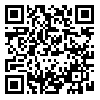Volume 1, Issue 4 (Journal of Clinical and Basic Research(JCBR) 2017)
jcbr 2017, 1(4): 36-40 |
Back to browse issues page
Download citation:
BibTeX | RIS | EndNote | Medlars | ProCite | Reference Manager | RefWorks
Send citation to:



BibTeX | RIS | EndNote | Medlars | ProCite | Reference Manager | RefWorks
Send citation to:
Rostamani M, Rostamani A A, Rostamani H R, Fallah S, Mousavi H S, Jenabian E. Occupational Stress among Female Employees of the Golestan University of Medical Sciences in 2015. jcbr 2017; 1 (4) :36-40
URL: http://jcbr.goums.ac.ir/article-1-117-en.html
URL: http://jcbr.goums.ac.ir/article-1-117-en.html
Mahdis Rostamani1 
 , Ali Akbar Rostamani *2
, Ali Akbar Rostamani *2 
 , Hamid Reza Rostamani3
, Hamid Reza Rostamani3 
 , Saeed Fallah4
, Saeed Fallah4 
 , Hadis Sadat Mousavi1
, Hadis Sadat Mousavi1 
 , Ensieh Jenabian1
, Ensieh Jenabian1 


 , Ali Akbar Rostamani *2
, Ali Akbar Rostamani *2 
 , Hamid Reza Rostamani3
, Hamid Reza Rostamani3 
 , Saeed Fallah4
, Saeed Fallah4 
 , Hadis Sadat Mousavi1
, Hadis Sadat Mousavi1 
 , Ensieh Jenabian1
, Ensieh Jenabian1 

1- Department of Research and Technology, Golestan University of Medical Sciences, Gorgan
2- Faculty of Dentistry, Golestan University of Medical Sciences, Gorgan
3- Security Administration, Golestan University of Medical Sciences, Gorgan
4- Health Management and Social Development Research Center, Golestan University of Medical Sciences, Gorgan
2- Faculty of Dentistry, Golestan University of Medical Sciences, Gorgan
3- Security Administration, Golestan University of Medical Sciences, Gorgan
4- Health Management and Social Development Research Center, Golestan University of Medical Sciences, Gorgan
Abstract: (5338 Views)
Introduction: Occupational stress results from work demands and pressures that are not matched with abilities and characteristics of an employee. It is one of the main causes of job dissatisfaction, absenteeism, work delays, desertion and early retirement. Therefore, the present study aimed to evaluate occupational stress among female employees working at the Golestan University of Medical Sciences, Iran. Materials and Methods: This cross-sectional and descriptive-analytical study was performed in 2015 on 400 female employees of the university who were enrolled via stratified and quota sampling. Data were collected using the standard Osipow occupational stress questionnaire and a demographic questionnaire. The data were analyzed in SPSS (version 16) using independent t-test, ANOVA and Tukey’s test. P-values less than 0.05 were considered statistically significant. Results: Mean total score of occupational stress was 173.44 ± 25.15. Role ambiguity (score: 33.57 ± 5.74) and physical environment (score: 22.56 ± 8.44) had the highest and lowest impact on occupational stress, respectively. Moreover, 146 contractual employees (52.1%) experienced occupational stress. Total occupational stress was significantly correlated with all study variables including education level (P=0.02), income (P=0.0001), service sector (P=0.001), marital status (P=0.01), employment status (P=0.0001) and work experience (P=0.04). Conclusions: Role ambiguity is the main source of stress for female employees working at the Golestan University of Medical Sciences. Therefore, it is necessary to design individual and organization trainings to help employees overcome role ambiguity.
| Rights and permissions | |
 |
This work is licensed under a Creative Commons Attribution-NonCommercial 4.0 International License. |



